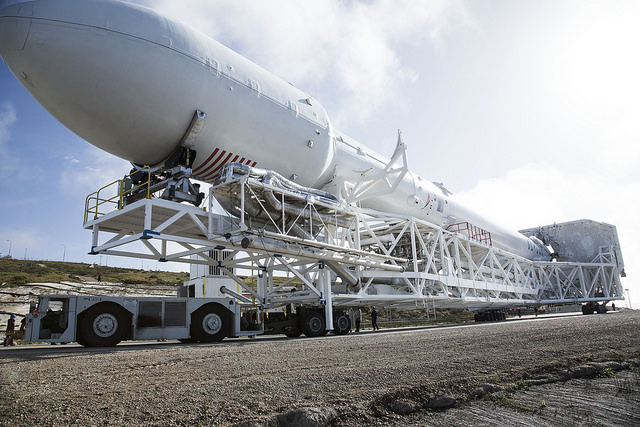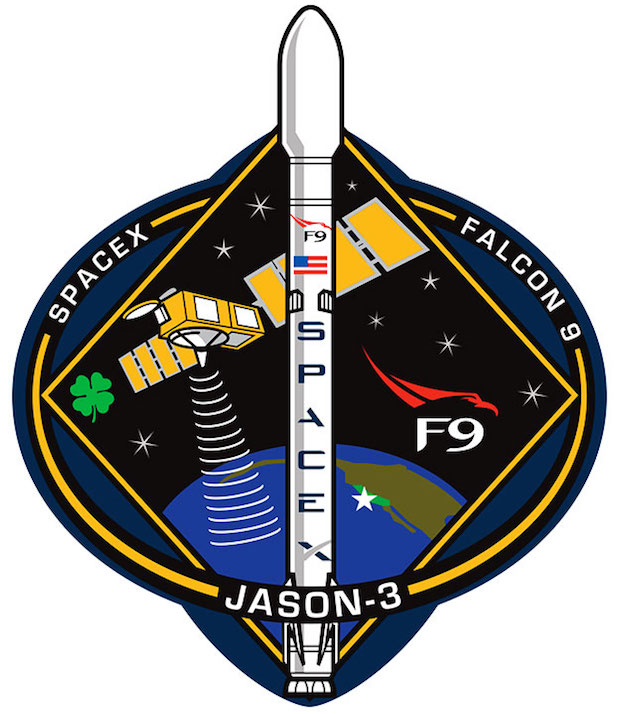
Meteorologists predict mostly sunny skies, mild temperatures and light winds Sunday for the launch of a SpaceX Falcon 9 rocket from California’s Central Coast with a $364 million oceanography satellite for U.S. and European science institutions.
The forecast is so favorable that U.S. Air Force meteorologists give a 100 percent chance of acceptable conditions for the Falcon 9 rocket’s 30-second launch window, which opens at 10:42:18 a.m. PST (1:42:18 p.m. EST; 1842:18 GMT) Sunday.
The Jason 3 satellite is buttoned up inside the nose shroud of the Falcon 9 rocket, poised for a five-year mission to measure the height of waves and monitor rising sea levels around the world.
The Falcon 9 rocket emerged from its hangar at Space Launch Complex 4-East on Friday, and SpaceX technicians lifted the 224-foot-tall rocket vertical Saturday morning over the facility’s concrete flame trench.
“The Falcon 9 rocket and the Jason 3 spacecraft are ready,” said Tim Dunn, the NASA launch manager for Sunday’s flight. “The launch team is prepared and excited to be here at Vandenberg, and we’re poised to launch this important mission for our nation.”
Led by NOAA and Eumetsat, Europe’s weather satellite agency, the Jason 3 mission is the fourth in a series of satellites that have continuously tracked ocean conditions since 1992.
If launch does not occur Sunday, the mission has a backup launch date Monday at 10:31 a.m. PST (1:31 p.m. EST; 1831 GMT). Weather conditions are forecast to deteriorate after Sunday’s launch window, with a 60 percent probability of good weather Monday, according to the official Air Force outlook.
The Air Force-operated range at Vandenberg is currently unavailable for much of the rest of January.
But launch preparations are going smoothly, and SpaceX plans to switch on the rocket and poll the launch team for a “go” to begin loading kerosene and liquid oxygen propellants into the two-stage booster at about 6:30 a.m. PST (9:30 a.m. EST; 1430 GMT) Sunday.
Kerosene will first be pumped into the rocket, followed by cryogenic liquid oxygen starting at about 8 a.m. PST (11 a.m. EST; 1600 GMT).
The launch crew will test the rocket’s destruct mechanism and communications equipment, then a final status check of the SpaceX team 13 minutes before liftoff will give approval to start the terminal countdown sequence at T-minus 10 minutes.
In the final segment of the countdown, the computer-controlled sequencer will run super-cold propellant into the first stage’s engine section to condition the Merlin engines for ignition, retract the launch pad’s strongback support structure, and pressurize the fuel tanks.

The nine-engine first stage will ignite just before the countdown reaches zero, power up to full throttle and go through a fast-paced automated health check before hold-down clamps disengage to release the rocket for liftoff from its hillside launch pad.
The rocket will pitch on a south-southeast path away from Vandenberg, surpassing the speed of sound about 70 seconds after liftoff before switching off its first stage engines at T+plus 2 minutes, 34 seconds.
Moments later, the first stage will fall away, kicking off maneuvers to reorient itself for a pre-programmed autopilot descent to a barge in the Pacific Ocean less than 200 miles downrange from Vandenberg. The landing try is the latest experiment in SpaceX’s widely-watched effort to recover its rocket boosters and fly them again.
If SpaceX perfects the reusability technique, some missions with heavy satellites or payloads bound for high orbits will still need to come down on a landing platform at sea. Launches carrying lighter cargo have enough leftover fuel to steer back to a touchdown on land.
The Falcon 9’s second stage, propelled by a single Merlin engine, will inject the 1,124-pound (510-kilogram) Jason 3 satellite into an elliptical parking orbit about nine minutes after liftoff, around the same time the 14-story first stage booster is approaching the SpaceX landing ship.
A second burn of the upper stage engine will alter the spacecraft’s orbit to a near circular path around Earth at an altitude of about 824 miles (1,326 kilometers) and an inclination of 66 degrees.
Spacecraft separation is scheduled for T+plus 55 minutes, 48 seconds, followed a few minutes later by deployment of Jason 3’s two solar array wings, which will open one at a time to begin charging the satellite’s batteries.
Jason 3 is a joint project between NOAA, Eumetsat, the French space agency CNES, and NASA, which manages the satellite’s launch and U.S.-built science instruments.
Sunday’s launch is the first Falcon 9 launch of the year, and SpaceX’s first flight from Vandenberg since September 2013. It also marks SpaceX’s 26th space launch overall, and the 21st flight of a Falcon 9 rocket since it debuted in June 2010.
Email the author.
Follow Stephen Clark on Twitter: @StephenClark1.



